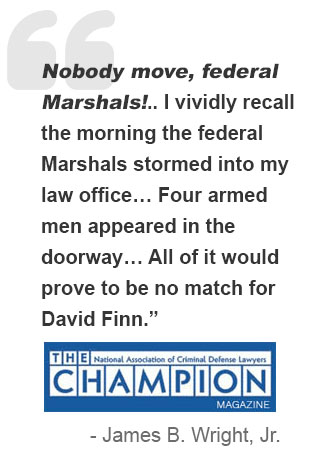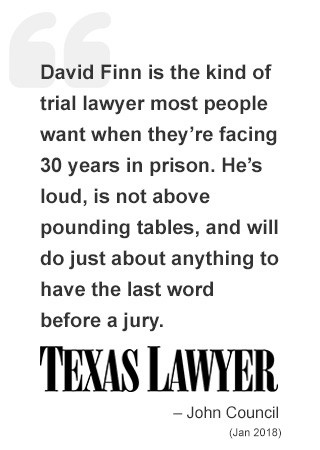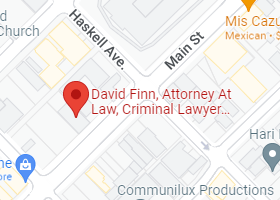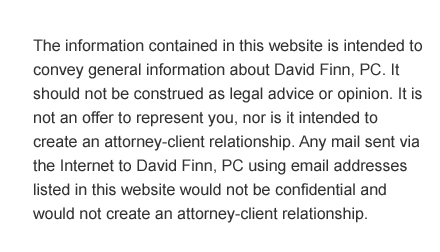


Data Privacy & The 4th Amendment
NACDL Champion Magazine
May 2005, Page 20
Data Privacy And The Vanishing Fourth Amendment
By Daniel J. Solove
To live in the modern world, we must enter into numerous relationships with other people and businesses: doctors, lawyers, merchants, magazines, newspapers, banks, credit card companies, employers, landlords, ISPs, insurance companies, phone companies, and cable companies. The list goes on and on. Our relationships with all of these entities generate records containing personal information necessary to establish an account and record our transactions and preferences. We are becoming a society of records, and these records are not held by us, but by third parties.
These record systems are becoming increasingly useful to law enforcement officials. Personal information can help the government detect fraud, espionage, fugitives, drug distribution rings, and terrorist cells. Information about a personâs financial transactions, purchases, and religious and political beliefs can assist the investigation of suspected criminals and can be used to profile people for more thorough searches at airports.
Fourth Amendment, Records, And Privacy
The U.S. Supreme Court held that there is no reasonable expectation in privacy for information known or exposed to third parties. In United States v. Miller, federal agents presented subpoenas to two banks to produce the defendantâs financial records. The defendant argued that the Fourth Amendment required a warrant, not a subpoena, but the High Court concluded that the amendment didnât apply. There is no reasonable expectation of privacy in the records, the Court reasoned, because the information is ârevealed to a third party.â?1 Thus, âchecks are not confidential communications but negotiable instruments to be used in commercial transactions. All of the documents obtained, including financial statements and deposit slips, contain only information voluntarily conveyed to the banks and exposed to their employees in the ordinary course of business.â?2
The Court used similar reasoning in Smith v. Maryland. Without a warrant, the police asked a telephone company to use a pen register, which is a device installed at the phone company to record the numbers dialed from the defendantâs home. The Court concluded that since people âknow that they must convey numerical information to the phone company,â? they cannot âharbor any general expectation that the numbers they dial will remain secret.â?3
Miller and Smith establish a general rule that if information is in the hands of third parties, then an individual lacks a reasonable expectation of privacy in that information, which means that the Fourth Amendment does not apply.4 Individuals thus probably do not have a reasonable expectation of privacy in communications and records maintained by ISPs or computer network administrators.5
The third party record doctrine stems from the secrecy paradigm. If information is not completely secret, if it is exposed to others, then it loses its status as private. Smith and Miller have been extensively criticized throughout the past several decades. However, it is only recently that we are beginning to see the profound implications of the third party doctrine. Smith and Miller are the new Olmstead v. United States, where the Court in 1928 concluded that wiretapping was not protected by the Fourth Amendment.6
For nearly 40 years until it was reversed in Katz v. United States,7 the governmentâs power to engage in wiretapping and other forms of electronic surveillance fell outside of the reach of the Fourth Amendment, and the legislation that filled the void was ineffective. Gathering information from third party records is an emerging law enforcement practice with as many potential dangers as the wiretapping in Olmstead. âThe progress of science in furnishing the government with means of espionage is not likely to stop with wiretapping,â?
Justice Brandeis observed in his Olmstead dissent. âWays may some day be developed by which the government, without removing papers from secret drawers, can reproduce them in court, and by which it will be enabled to expose to a jury the most intimate occurrences of the home.â?8
That day is here. The governmentâs harvesting of information from the extensive dossiers being assembled with modern computer technology poses one of the most significant threats to privacy of our times.9
Emerging Statutory Regime And Its Limits
Throughout the twentieth century, when the Supreme Court held that the Fourth Amendment was inapplicable to new practices or technology, Congress often responded by passing statutes that afforded some level of protection. Through a series of statutes, Congress has established a regime regulating government access to third party records. This regime erects a particular architecture significantly different from that of the Fourth Amendment. Unfortunately, this regime is woefully inadequate.
Procedural Requirements To Obtain Information. The most significant deficiency is that a majority of the statutes permit government access to third party records with only a court order or subpoena â a significant departure from the Fourth Amendment, which generally requires warrants supported by probable cause to be issued by a neutral and detached judge. Unlike warrants, subpoenas do not require probable cause and can be issued without judicial approval. Prosecutors, not neutral judicial officers, can issue subpoenas.10
According to Stuntz: â[W]hile searches typically require probable cause or reasonable suspicion and sometimes require a warrant, subpoenas require nothing, save that the subpoena not be unreasonably burdensome to its target. Few burdens are deemed unreasonable.â?11 According to legal scholar Ronald Degnan, subpoenas are not issued âwith great circumspectionâ? and are often âhanded out blank in batches and filled in by lawyers.â?12 As Stuntz contends, federal subpoena power is âakin to a blank check.â?13
Prosecutors can also use grand jury subpoenas to obtain third party records.14 Grand jury subpoenas are âpresumed to be reasonableâ? and may only be quashed if âthere is no reasonable possibility that the category of materials the Government seeks will produce information relevant to the general subject of the grand jury investigation.â?15 As Stuntz observes, grand jury subpoenas âare much less heavily regulatedâ? than search warrants:
As long as the material asked for is relevant to the grand juryâs investigation and as long as compliance with the subpoena is not too burdensome, the subpoena is enforced. No showing of probable cause or reasonable suspicion is necessary, and courts measure relevance and burden with a heavy thumb on the governmentâs side of the scales.16
Therefore, courts âquash or modifyâ? subpoenas only âif compliance would be unreasonable or oppressive.â?17 Further, âjudges decide these motions by applying vague legal standards case by case.â?18
Court orders under most of the statutes are not much more constrained than subpoenas. They typically require mere ârelevanceâ? to an ongoing criminal investigation, a standard significantly lower and looser than probable cause.
The problem with subpoenas and court orders is that they supply the judiciary with greatly attenuated oversight powers. The role of the judge in issuing or reviewing subpoenas is merely to determine whether producing records is overly burdensome. With this focus, financial hardship in producing information would give courts more pause when reviewing subpoenas than would threats to privacy. The role of the judiciary in court orders is also quite restricted. Instead of requiring probable cause, court orders require the government to demonstrate that records are ârelevantâ? to a criminal investigation, a much weaker standard. In short, judicial involvement with subpoenas and court orders amounts to little more than a rubber stamp of judicial legitimacy.
Wiretapping And Bugging. When the Court held in Olmstead that the Fourth Amendment did not apply to wiretapping, Congress responded six years later by enacting § 605 of the Federal Communications Act of 1934. As discussed earlier, § 605 was far too narrow and limited. In 1968, a year after the Supreme Court in Katz declared that the Fourth Amendment applied to wiretapping, Congress enacted Title III of the Omnibus Crime Control and Safe Streets Act,19 which greatly strengthened the law of wiretapping, extending its reach to state officials and private parties.
In 1986, Congress amended Title III with the Electronic Communications Privacy Act (ECPA). The ECPA restructured Title III into three parts, known as the âWiretap Act,â? which governs the interception of communications; the âStored Communications Act,â? which covers access to stored communications and records; and the âPen Register Act,â? which regulates pen registers and trap and trace devices.20
The Wiretap Act covers wiretapping and bugging. It applies when a communication is intercepted during transmission. The act has strict requirements for obtaining a court order to engage in electronic surveillance.21 In certain respects, the Wiretap Actâs requirements are stricter than those for a Fourth Amendment search warrant.
22 It also requires that the surveillance âminimize the interception of communicationsâ? not related to the investigation. The act is enforced with an exclusionary rule.23
However, the interception of electronic communications not involving the human voice (such as e-mail) are not protected with an exclusionary rule. Although the Wiretap Act has substantial protections, it covers ground already protected by the Fourth Amendment. In areas not protected by the Fourth Amendment, the architecture of the statutory regime is much weaker and more porous.
Stored Communications. Communications service providers frequently store their customersâ communications. ISPs temporarily store e-mail until it is downloaded by the recipient. Many ISPs enable users to keep copies of previously read e-mails on the ISPâs server, as well as copies of their sent emails. Since a third party maintains the information, the Fourth Amendment may not apply.24
The Stored Communications Act provides some protection, but unfortunately it is quite confusing and its protection is limited. Electronic storage is defined as âany temporary, intermediate storage of a wire or electronic communication incidental to the electronic transmission thereof,â? and âany storage of such communication by an electronic communication service for purposes of backup protection.â?25 This definition clearly covers e-mail that is waiting on the ISPâs server to be downloaded. But what about previously read e-mail that remains on the ISPâs server? According to the Department of Justiceâs (DOJ) interpretation of the act, the email is no longer in temporary storage, and is therefore âsimply a remotely stored file.â?26 The act permits law enforcement officials to access it merely by issuing a subpoena to the ISP.27 And in contrast to the Wiretap Act, the Stored Communications Act does not have an exclusionary rule.
Communications Service Records. The Stored Communications Act also regulates government access to a customerâs communications service records, which consist of the customerâs name, address, phone numbers, payment information, and services used.28 One of the most important pieces of information in ISP records is the customerâs identity. An ISP may have information linking a customerâs screen name to her real name. Thus, an ISP often holds the key to oneâs ability to communicate anonymously on the Internet. The government often wants to obtain this information to identify a particular speaker. To access customer records, the government must obtain a court order, which requires âspecific and articulable facts showing that there are reasonable grounds to believe that . . . the records or other information sought, are relevant and material to an ongoing criminal investigation.â?29 Further, since the act lacks an exclusionary rule, information obtained in violation of the law can still be introduced in court.30
Pen Registers, E-mail Headers, And Websurfing. The Pen Register Act attempts to fill the void left by Smith v. Maryland by requiring a court order to use a pen register or trap and trace device.31 Whereas a pen register records the phone numbers a person dials from her home, a trap and trace device creates a list of the telephone numbers of incoming calls. The USA-PATRIOT Act, passed in 2001 shortly after the September 11th attacks, expanded the scope of the Pen Register Act. The definition of a pen register now extends beyond phone numbers to also encompass addressing information on e-mails and IP addresses. An IP address is the unique address assigned to a particular computer connected to the Internet. All computers connected to the Internet have one. Consequently, a list of IP addresses accessed reveals the various Web sites that a person has visited.
Because Web sites are often distinctively tailored to particular topics and interests, a comprehensive list of them can reveal a lot about a personâs life. The court order to obtain this information, however, only requires the government to demonstrate that âthe information likely to be obtained . . . is relevant to an ongoing criminal investigation.â?32 Courts cannot look beyond the certification nor inquire into the truthfulness of the facts in the application. Once the government official makes the proper certification, the court must issue the order.33 As one court has observed, the âjudicial role in approving use of trap and trace devices is ministerial in nature.â?34 Finally, there is no exclusionary rule for Pen Register Act violations.
Financial Records. Two years after United States v. Miller, Congress filled the void with the Right to Financial Privacy Act (RFPA) of 1978, which requires the government to obtain a warrant or subpoena to access records from banks or other financial institutions.35 However, the subpoena merely requires a âreason to believe that the records sought are relevant to a legitimate law enforcement inquiry.â?36 When subpoena authority is not available to the government, the government need only submit a formal written request for the information.37
In addition to banks, credit reporting agencies have detailed records for nearly every adult American consumer. Under the Fair Credit Reporting Act (FCRA) of 1970, a consumer reporting agency âmay furnish identifying information respecting any consumer, limited to his name, address, former addresses, places of employment, or former places of employment, to a governmental agency.â?38 Thus, the government can simply request this information without any court involvement. And the government can obtain more information with a court order or grand jury subpoena.39 Since the FCRA focuses on credit reporting agencies, it doesnât prohibit the recipients of credit reports from disclosing them to the government.
Although the RFPA and FCRA protect financial information maintained by banks and credit reporting agencies, the government can obtain financial information from employers, landlords, merchants, creditors, and database companies, among others. Therefore, financial records are protected based only on which entities possess them. Thus, the statutory regime merely provides partial protection of financial data.
Electronic Media Entertainment Records. The statutory regime protects records pertaining to certain forms of electronic media entertainment. Under the Cable Communications Policy Act (Cable Act) of 1984,40 a government official must obtain a court order in order to obtain cable records. The government must offer âclear and convincing evidence that the subject of the information is reasonably suspected of engaging in criminal activity and that the information sought would be material evidence in the case.â?41 People can âappear and contestâ? the court order.42 This standard is more stringent than the Fourth Amendmentâs probable cause and warrant requirements. However, there is no exclusionary rule under the Cable Act.
In addition to cable records, the statutory regime also protects videotape rental records. The Video Privacy Protection Act (VPPA) of 1988 states that a videotape service provider may disclose customer records to law enforcement officials âpursuant to a warrant . . . , an equivalent state warrant, a grand jury subpoena, or a court order.â?43 Unlike the Cable Act, the level of protection under the VPPA is much less stringent.
Although the statutory regime protects the records of certain forms of electronic media entertainment, it fails to protect the records of many others. For example, records from music stores, electronics merchants, and Internet media entities are afforded no protection.
Medical Records. Our medical records are maintained by third parties. Could the third party doctrine extend to medical records? On the one hand, given the considerable privacy protection endowed upon the patient-physician relationship, the third party doctrine may stop at the hospital door.44 On the other hand, the doctrine applies to records of financial institutions, which also have a tradition of maintaining the confidentiality of their customersâ information.45 Unless the patient-physician relationship is distinguished from banks, the third party doctrine logically could apply to medical records. However, the Supreme Court has yet to push the doctrine this far.
The federal health privacy rules under the Health Insurance Portability and Accountability Act (HIPAA) of 1996 apparently view medical records as falling under the third party doctrine. The rules permit law enforcement officials to access medical records with a mere subpoena.46 Health information may also be disclosed âin response to a law enforcement officialâs request for such information for the purpose of identifying or locating a suspect, fugitive, material witness, or missing person.â?47
Moreover, not all health records are covered by HIPAA. Only records maintained by health plans, health care clearinghouses, and health care providers are covered.48 Although doctors, hospitals, pharmacists, health insurers, and HMOs are covered, not all third parties possessing our medical information fall under HIPAA. For example, the sale of nonprescription drugs and the rendering of medical advice by many Internet health Websites are not covered by HIPAA.49 Therefore, while certain health records are protected, others are not.
Holes In The Regime. Federal statutes provide some coverage of the void left by the inapplicability of the Fourth Amendment to records held by third parties. Although the statutes apply to communication records, financial records, entertainment records, and health records, these are only protected when in the hands of particular third parties. Thus, the statutory regime does not protect records based on the type of information contained in the records, but protects them based on the particular types of third parties that possess them.
Additionally, there are gaping holes in the statutory regime of protection, with classes of records not protected at all. Such records include those of merchants, both online and offline. Records held by bookstores, department stores, restaurants, clubs, gyms, employers, and other companies are not protected. Additionally, all the personal information amassed in profiles by database companies is not covered. Records maintained by Internet retailers and Web sites are often not considered âcommunicationsâ? under the ECPA; the government can access these records and the ECPA doesnât apply. Thus, the statutory regime is limited in its scope and has glaring omissions and gaps. Further, the statutes are often complicated and confusing, and their protection turns on technical distinctions that can leave wide fields of information virtually unprotected.
Therefore, the current statutory regime is inadequate. As warrants supported by probable cause are replaced by subpoenas and court orders supported by âarticulable factsâ? that are ârelevantâ? to an investigation, the role of the judge in the process is diminished to nothing more than a decorative seal of approval. And since there are numerous holes in the regime, there are many circumstances when neither court orders nor subpoenas are required. The government can simply ask for the information. An individualâs privacy is protected only by the vague and toothless privacy policies of the companies holding their information.
Notes
1. 425 U.S. 435, 443 (1976).
2. Id., 442.
3. 442 U.S. 735, 743 (1979).
4. See Orin S. Kerr, U.S. Depât of Justice, Searching and Seizing Computers and Obtaining Electronic Evidence in Criminal Investigations, § I.B.3 (Jan. 2001). Kerr, who wrote the DOJâs manual, is now a law professor and a leading expert in electronic surveillance law.
5. Id., § I.C.1(b)(iv).
6. 277 U.S. 438 (1928).
7. 389 U.S. 347 (1967).
8. Olmstead, 277 U.S. 438, 474 (1928) (Brandeis, J., dissenting).
9. See Jerry Berman & Deirdre Mulligan, Privacy in the Digital Age: Work in Progress, 23 Nova L. Rev. 551, 563â64 (1999).
10. Louis Fisher, Congress and the Fourth Amendment, 21 Ga. L. Rev. 107, 152 (1986).
11. William J. Stuntz, O.J. Simpson, Bill Clinton, and the Transsubstantive Fourth Amendment, 114 Harv. L. Rev. 842, 857-58 (2001).
12. Ronan E. Degnan, Obtaining Witnesses and Documents (or Things), 108 F.R.D. 223, 232 (1986).
13. Stuntz, O.J. Simpson, 864.
14. Grand juries are still used in some states as well as in the federal system. See Degnan, Obtaining Witnesses, 229.
15. United States v. R. Enter., Inc., 498 U.S. 292, 301 (1991).
16. William J. Stuntz, Privacyâs Problem and the Law of Criminal Procedure, 93 Mich. L. Rev. 1016, 1038 (1995).
17. Oklahoma Press Pub. Co. v. Walling Wage, and Hour Admin., 327 U.S. 186, 208â09 (1946).
18. Stuntz, O.J. Simpson, 867.
19. Omnibus Crime and Control and Safe Streets Act of 1968, 18 U.S.C. §§ 2510â22 (2001).
20. 18 U.S.C. §§ 2510â22 (Wiretap Act); 18 U.S.C. §§ 2701â11 (Stored Communications Act); 18 U.S.C. §§ 3121â27 (Pen Register Act).
21. Id. § 2518.
22. See Orin S. Kerr, Internet Surveillance Law after the USA-Patriot Act: The Big Brother That Isnât, 97 Nw. U. L. Rev. 607, 621 (2003).
23. 18 U.S.C. § 2518 (10)(a).
24. This conclusion is debatable, however, because telephone companies can also store telephone communications, and it is unlikely that the Court would go so far as to say that this fact eliminates any reasonable expectation of privacy in such communications.
25. 18 U.S.C. § 2510(17) (emphasis added).
26. Kerr, Searching and Seizing, § III.B.
27. Id., § III.D.1.
28. 18 U.S.C. § 2703(c)(1)(C).
29. 18 U.S.C. § 2703(d).
30. See, e.g., United States v. Hambrick, 55 F. Supp.2d 504 (W.D. Va. 1999). For a compelling argument for why electronic surveillance statutes should have an exclusionary rule, see Orin S. Kerr, Lifting the âFogâ of Internet Surveillance: How a Suppression Remedy Would Change Computer Law, 54 Hastings L.J. 805 (2003).
31. 18 U.S.C. § 3121(a).
32. 18 U.S.C. § 3123(a).
33. âUpon application made under §3122(a)(1), the court shall enter an ex parte order authorizing the installation and use of a pen register or trap and trace device. . . .â? Id. §3123 (a)(1).
34. United States v. Fregoso, 60 F.3d 1314, 1320 (8th Cir. 1995). See also Kerr, Searching and Seizing, § IV.B.
35. See 29 U.S.C. §§ 3401â22.
36. 29 U.S.C. § 3407.
37. 29 U.S.C. § 3408.
38. 15 U.S.C. § 1681f.
39. 15 U.S.C. § 1681b(a)(1).
40. 47 U.S.C. § 551.
41. 47 U.S.C. § 551(h)(1).
42. 47 U.S.C. § 551(h)(2).
43. 8 U.S.C. § 2710(b)(2)(C).
44. Protection of patient-physician confidentiality extends back to the Hippocratic Oath, circa 400 BC. For a discussion of the
extensive legal protection accorded to the patient-physician relationship, see Daniel J. Solove & Marc Rotenberg, Information Privacy Law 217â44 (2003).
45. Under the breach of confidentiality tort, doctors and banks can be liable for breaching confidentiality. See McCormick v. England, 494 S.E.2d 431 (S.C. Ct. App. 1997) (patient-physician confidentiality); Peterson v. Idaho First National Bank, 367 P.2d 284 (Idaho 1961) (bank-customer confidentiality).
46. 45 C.F.R. § 164.512(f)(1)(ii).
47. Id. § 164.512(f)(2).
48. 45 C.F.R. § 160.102.
49. Pew Internet & American Life Project, Exposed Online: Why the New Federal Health Privacy Regulation Doesnât Offer Much Protection to Internet Users 6â8 (Nov. 2001).
Excerpted and adapted from Daniel J. Soloveâs The Digital Person: Technology and Privacy in the Information Age, published in 2004 by New York University Press.
——————————————————————————–
National Association of Criminal Defense Lawyers (NACDL)
1150 18th St., NW, Suite 950, Washington, DC 20036
(202) 872-8600 ⢠Fax (202) 872-8690 ⢠assist@nacdl.org
Phone Numbers
Office: (214) 538-6629







